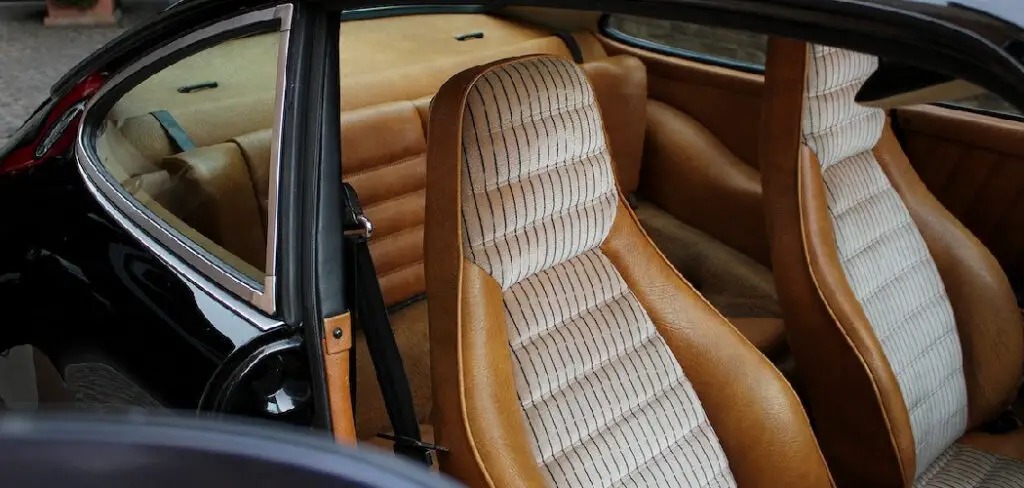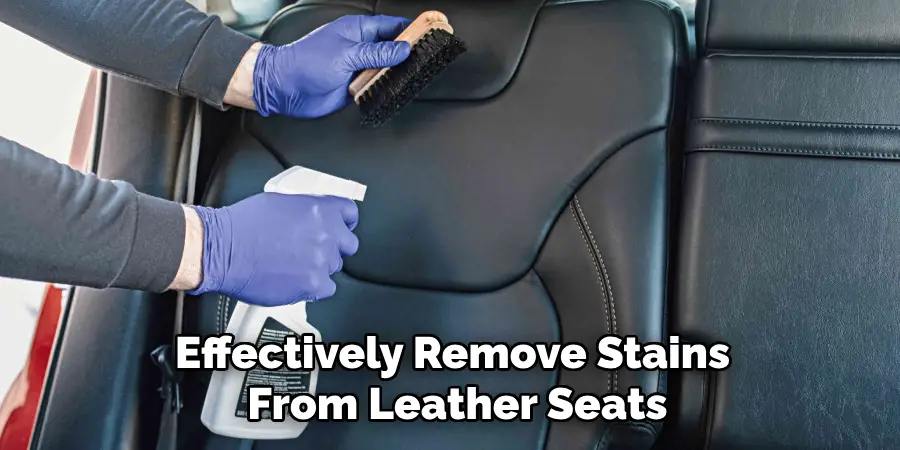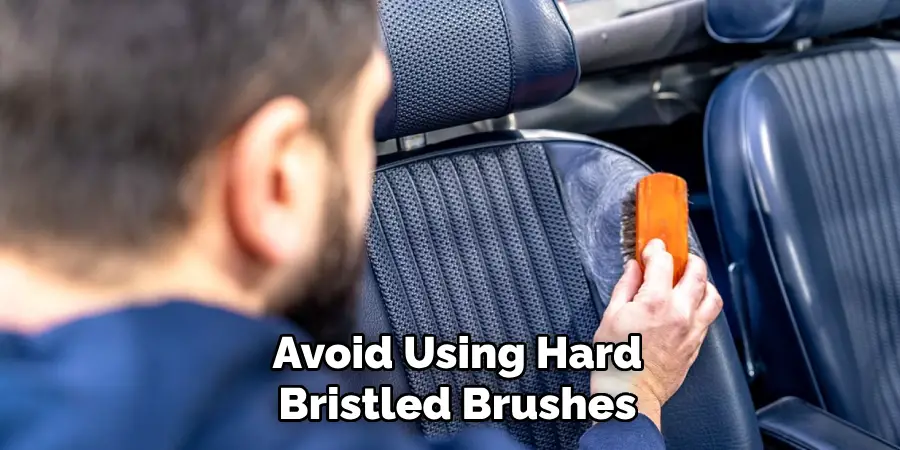Keeping leather seats clean and free from stains not only enhances the appearance of your vehicle but also extends the lifespan of the leather. Leather is a durable and luxurious material, but it requires proper care and maintenance to preserve its beauty and functionality.

This guide on how to get stains off leather seats will provide you with effective techniques and tips for removing stains from leather seats, ensuring they remain in pristine condition. Whether dealing with spills, scuffs, or everyday dirt, understanding the right methods and products to use is crucial for maintaining the quality and look of your leather interiors.
Why is It Important to Remove Stains From Leather Seats?
Removing stains from leather seats is essential for several reasons. First and foremost, stains can cause permanent damage to the leather if not addressed promptly, potentially leading to discoloration and weakening of the material.
Over time, untreated stains can set into the leather, making them increasingly difficult to remove and compromising the seat’s aesthetic appeal. Furthermore, maintaining clean leather seats can significantly enhance the overall value and resale potential of your vehicle, as pristine interiors are a key factor in a car’s desirability.
Additionally, by removing stains promptly, you are practicing good hygiene, preventing the buildup of bacteria and odors that can stem from spills and dirt accumulation. Regular maintenance and cleaning ensure that your leather seats remain comfortable, attractive, and long-lasting.
8 Step-by-step Guidelines on How to Get Stains Off Leather Seats
Step 1: Gather the Necessary Supplies
To effectively remove stains from leather seats, you will need a few supplies that are safe for leather materials. These may include:
- A Soft-bristled Brush or Toothbrush
- Mild Soap or Leather Cleaner
- Distilled Water
- White Vinegar or Rubbing Alcohol (for Tougher Stains)
- Clean Towels or Microfiber Cloths
- Leather Conditioner

Step 2: Identify the Type of Stain
Before you begin the cleaning process, it’s crucial to identify the type of stain on your leather seats. Different stains require specific treatment methods to ensure successful removal without damaging the leather. Common stains include oil, ink, dye transfers, and food spills.
To effectively determine the stain type, examine the color, texture, and circumstances under which the stain appeared. Knowing the nature of the stain will allow you to select the appropriate cleaning agents and techniques, ensuring a safer and more efficient stain-removal process.
Step 3: Test on a Small Area First
Before applying any cleaning solution to the entire stain, it’s crucial to test it on a small, inconspicuous area of your leather seat first. This will prevent any potential damage or discoloration that may occur with certain cleaning agents. Apply the cleaner and let it sit for a few minutes before wiping it off with a clean cloth. If there are no adverse effects, continue with the rest of the stain removal process.
The spot test is especially important for colored leather seats, as they are more prone to discoloration from certain cleaning agents.
Step 4: Blot the Stain With a Clean Cloth
Once you’re confident that your cleaning solution won’t harm the leather, begin the stain removal process by gently blotting the stain with a clean, dry cloth.
Avoid rubbing the stain, as this may cause it to spread or push it deeper into the leather. Instead, carefully dab at the stain to lift as much of the substance as possible. If the stain is still visible, moisten the cloth with distilled water or a diluted mixture of your chosen cleaner and continue blotting.
Keep using a fresh section of the cloth to prevent redistributing the stain onto the leather surface. This step is essential for absorbing any excess material and for making the subsequent cleaning steps more effective.
Step 5: Use a Soft Brush or Toothbrush to Gently Scrub
For tougher stains, you can use a soft-bristled brush or toothbrush to gently scrub the affected area. This will help loosen and remove any residual material from the leather without causing damage. Avoid using hard-bristled brushes that can scratch or scuff the leather surface.

You can also make a mild cleaning solution by mixing equal parts water and white vinegar or rubbing alcohol for more stubborn stains. Apply this mixture onto the stain and gently scrub with the brush before wiping it off with a damp cloth.
Step 6: Rinse Off With Distilled Water
After treating the stain and scrubbing the area, it’s important to rinse off any remaining cleaning solution to prevent residue from remaining on the leather. Dampen a clean cloth with distilled water and gently wipe over the area that you have just cleaned. Ensure that you use only enough water to moisten the cloth, as excessive moisture can damage the leather.
Continue wiping until the solution is removed, ensuring there are no traces left behind that could lead to discoloration or stickiness. Dry the area thoroughly with another clean, dry cloth to absorb any remaining water and to ensure the leather dries properly without leaving water marks.
Step 7: Apply Leather Conditioner
After cleaning and drying the leather, it’s essential to apply a leather conditioner to restore any moisture lost during the cleaning process. This will help prevent the leather from becoming dry or brittle and prolong its longevity.
Using a clean cloth, gently buff the conditioner onto the stain area, following the product instructions for application. Allow it to sit for a few minutes before wiping off any excess with a clean cloth.
Step 8: Repeat if Necessary
If there are still traces of the stain after completing all previous steps, you may need to repeat the entire process or focus on specific areas until the stain is completely removed.
For tougher stains such as ink or dye transfers, it may take multiple attempts to fully remove them. However, with patience and the appropriate cleaning techniques and products, you can effectively restore your leather seats to their original clean and attractive state.

Following these guidelines on how to get stains off leather seats and performing regular maintenance on your leather seats will keep them looking pristine and ensure they last for many years to come.
Additional Tips
Avoid Heat Exposure:
Keep leather seats away from direct sunlight and heat sources, as prolonged exposure can cause the leather to fade, dry out, and crack over time. Use sunshades or park in shaded areas to protect your seats from UV damage.
Regular Dusting:
Incorporate regular dusting into your cleaning routine. A simple wipe-down with a microfiber cloth can help prevent dust buildup and maintain the leather’s shine and luster.
Avoid Harsh Chemicals:
When cleaning your leather seats, avoid using harsh chemicals or solvents that can damage the material. Stick to mild soap or specialized leather cleaner for best results.
Clean Up Spills Immediately:
To minimize the chances of stains setting into your leather seats, clean up any spills as soon as possible. Use a clean cloth to gently blot out the excess liquid, then follow with a damp cloth to wipe away any remaining residue. Remember to avoid rubbing or scrubbing, as this can cause more extensive damage to the leather.
Regular Conditioning:
In addition to applying leather conditioner after cleaning, it’s essential to regularly condition your leather seats every 2-3 months. This will help maintain the natural oils in the leather and keep it supple and soft.
Professional Cleaning:
If a stain is particularly stubborn or if you’re unsure about how to properly clean your leather seats, it’s best to seek professional cleaning services. They have specialized equipment and expertise in handling different types of stains on leather materials and can ensure a thorough and safe cleaning process.
By following these tips and guidelines, you can effectively remove stains from your leather seats without causing any damage or discoloration.
Frequently Asked Questions
Q1: Can I Use Harsh Chemicals on Leather Seats to Remove Stains?
A: No, it’s not recommended to use harsh chemicals on leather as they can cause damage and discoloration. Stick to mild soap or specialized leather cleaners, and always test on a small area first.
Q2: How Do I Remove Oil Stains from Leather Seats?
A: For oil stains, gently blot the stain as much as possible with a clean cloth before applying a mixture of equal parts water and white vinegar. Let it sit for a few minutes before wiping it off with a damp cloth.
Q3: Can I Use Household Cleaners Like Bleach or Ammonia on Leather?
A: No, household cleaners like bleach and ammonia are too harsh for leather material and can cause significant damage. Stick to gentle cleaning solutions specifically made for leather.

Conclusion
Removing stains from leather seats requires careful attention and a gentle approach to avoid causing any damage or discoloration. By following these step-by-step guidelines on how to get stains off leather seats, you can effectively remove stains from your leather seats while preserving their quality and appearance.
Remember to always spot-test any cleaning solutions first, and be patient as some stains may require multiple treatments for complete removal. With proper maintenance and prompt stain removal, you can keep your leather seats looking pristine for years to come.
check it out to Rejuvenate Leather Seats

